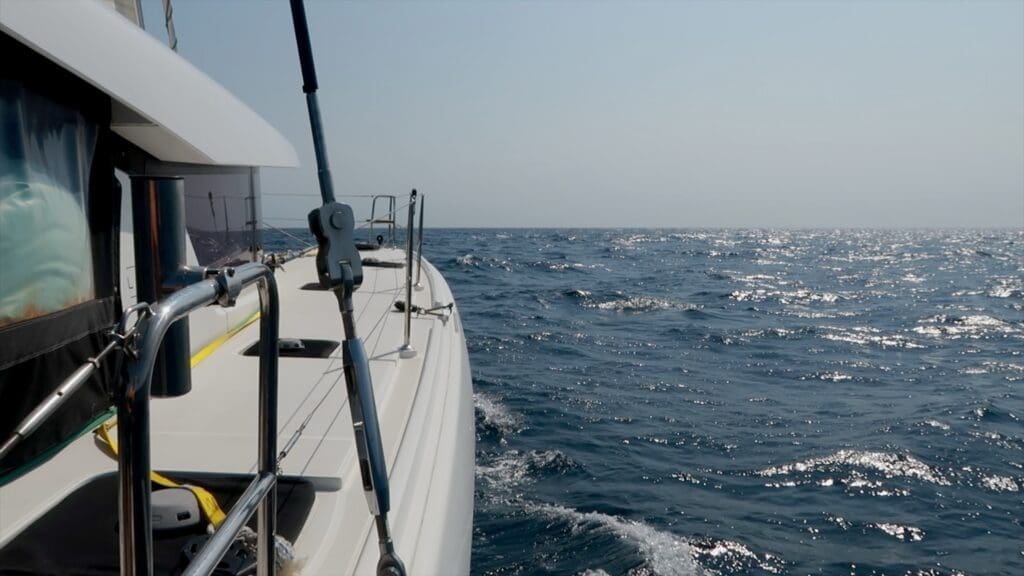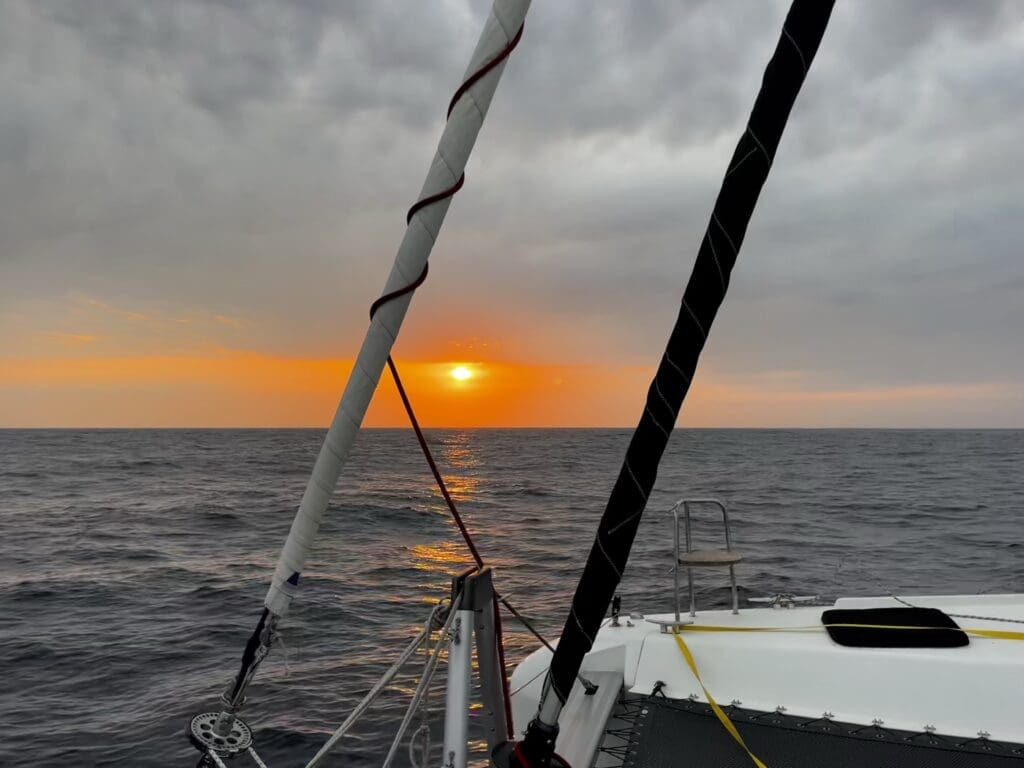We took three-hour shifts at the helm last night. The moonlight illuminated the sky, reflecting off the water and making the ocean look metallic. We were hauling ass. With 15-17kn of wind, Sabado was cruising along at 8.5kn, flying up to 10kn+ as we surfed down waves. It was exhilarating. I stood up for most of my first shift, watching the wind and our sails closely, inhaling the cool, clean ocean breeze. I can’t smell land anymore. We switched at midnight, and I sprawled out atop the lowered saloon table for some shut-eye.
My second shift felt completely different. By 3AM, the moon had disappeared, revealing glistening green bioluminescence around us. The wind had dropped to 10kn, our speed to 5.5kn. I had to wear a jacket, which felt silly after profusely sweating for over a month in Panama.
The wind continued to die during Ray’s next shift. He woke me up at sunrise to help bring out the gennaker. We flew it for a while, but our speed was still dipping below 5kn, so we decided to play around with our sail configuration. We furled in the gennaker, moved it over to our port bow, and brought it back out, gaining less than half a knot of speed. In our defense, there wasn’t much to gain with such little wind anyway. I laid back down, only to be woken up thirty minutes later to furl in the gennaker again as it was unhappily flapping around in the ultra-light wind. We brought out the jib instead, trying to sail wing on wing, with and without a barber hauler… you name it- we tried it. After all that effort, the best configuration we found was simply the full main and jib, no special tricks. We inched along the rest of the morning at 4kn, trying to remember that this passage is a marathon, not a sprint.

I evicted our first suicidal squid this afternoon. Poor little guys land on the deck during passages and dry out unless we’re lucky enough to notice and fling them back before it’s too late.

I came up from my after-lunch nap to 12kn of wind! It’s amazing what can change in three hours. Ray had adjusted our course per our weather router’s advice, and our speed was back up to 6.5kn. The cool, steady breeze had put us both in a great mood. I took the helm, and Ray crashed in the cockpit. The first few days of a longer passage are always the most difficult. Adjusting to sleeping in shifts is not for the faint of heart, especially when there are only two of you. All we have the energy to do is eat, sleep, and sail. I like having these updates to write and our YouTube videos to edit; it’s nice to have a project/something to accomplish each day other than just surviving and keeping the boat moving.
The wind dropped to 7kn just before dinner, so we brought out the gennaker (you know the drill by now). We were sailing slowly, but we were still sailing nonetheless! The boat was hitting its polar, meaning we were doing as well as possible, given the conditions. Unfortunately, as I am posting this, we have 3kn of wind and our port engine on. We’re disappointed but hopeful the wind will return soon…



16 Responses
Hang in there!! It is an adventure!! Cheers
And it’s only day 2!!?
Grateful for these updates! We are rooting for you and sending all our love from Portland!
We love and miss you guys! ❤️
You are so correct, it is not a sprint but a marathon. Thanks for keeping us up to date.
Got to keep our eyes on the prize!
Hi there guys! Hope the winds get back on the 15kt range and stay there consistently.
Let me ask you a question about something you are living, and I’ve been wondering: the weather router. I use PredictWind as my primary source of weather forecast. I look at the various models for wind/gust speed/direction and wave direction/height/frequency forecasts. I compare with others forecast sources, especially Buoyweather and Windy. Then I cast off, and invariably the reality is different than my best guess at the forecast, sometime in a big way. But I’ve never used the service of a router, so I wonder how accurately they get, and therefore how worthwhile the cost is. What do you think? What’s your experience with weather routers? Thanks! And good luck, as always! -Jorge
Hey Jorge! Great question. We use apps like predictwind (QTVLM moreso) unless we are making a long passage or a passage we are unfamiliar with. In those cases, we enlist the help of a pro. A professional weather router doesn’t limit themselves to grib data such as you get from Predictwind. The predictwind data doesn’t have the eyes of an experienced meteorologist looking at surface maps, high elevation data, satellite data, monitoring stations, buoy, and ship reports factoring into routing decisions.
Interestingly, we’ve found that it isn’t uncommon for the routes provided by the routers to be significantly different than what the computer models provide.
For this passage, we get at least daily communications from our router, and he fine-tunes things as we go. He helps us find that elusive wind or directs us to the counter-current that’s going to give us the push we need.
Oh yeah, and we can call him out if he screws things up! Try that with Predictwind. ??
Good Day be safe always. I am sure it is so exciting to be crossing another ocean. I was so glad to get this, as we think of you always. Fair winds and follow seas my friends
Thank you, Angelo! We’re looking forward to having something to post about on YouTube again. ⛵️ I hope you and your family (and your boat!) are doing well!
hi – those pictures are amazing. i am sending wind. i do hope it is the right kind! LOL
We’ll take any kind at this point! ?
cheering you on! ?
Can’t wait to see you guys! ⛵️
Loved reading your updates, Holly. Took more right back to doing an ocean crossing! We are thinking of you guys and hope the weather picks up soon. Fair winds, friend!
Anna and John
SV Coronado
Thank you! Looks like y’all are in the Bahamas, enjoy that crystal clear water for me!?